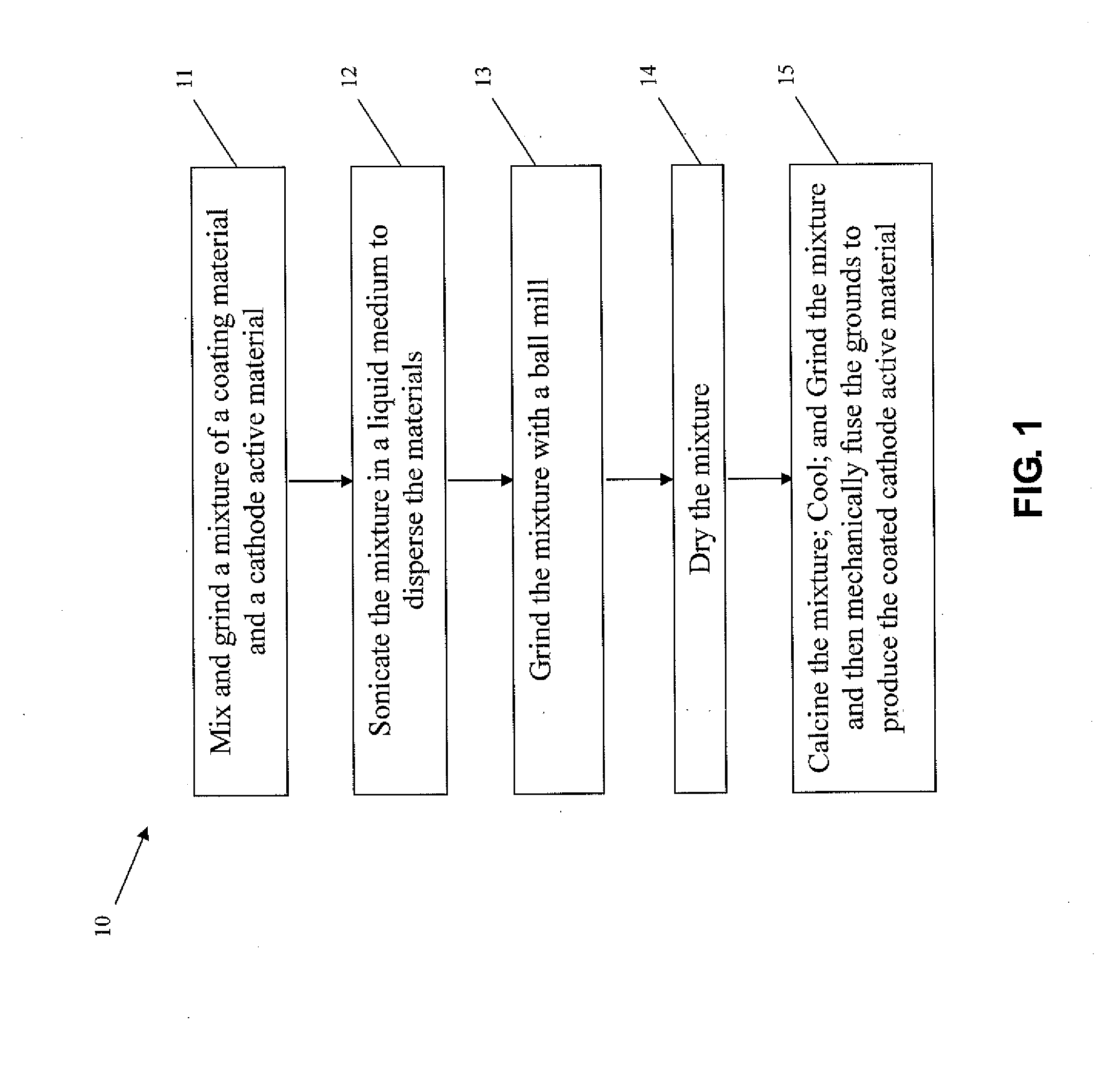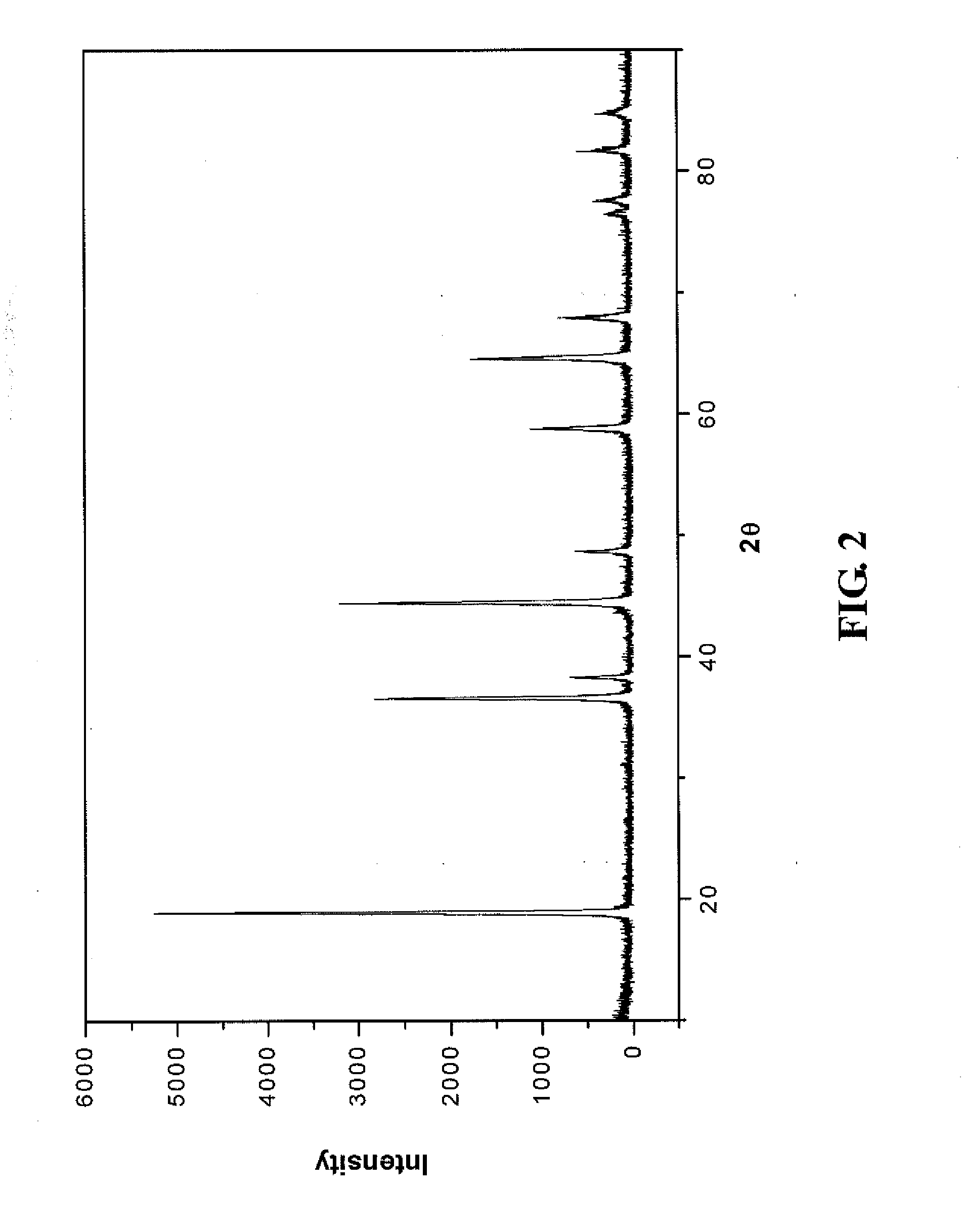METHODS FOR SURFACE COATING OF CATHODE MATERIAL LiNi0.5-XMn1.5MXO4 FOR LITHIUM-ION BATTERIES
a lithium-ion battery and cathode material technology, applied in the direction of non-aqueous electrolyte accumulator electrodes, cell components, electrolyte thermal treatment, etc., can solve the problems of high cost, unsafe, and scarce lithium cobalt oxide (licoosub>2/sub>) materials, and achieve high discharge rates and high cycle stability , the effect of simple synthesis method
- Summary
- Abstract
- Description
- Claims
- Application Information
AI Technical Summary
Benefits of technology
Problems solved by technology
Method used
Image
Examples
example 1
[0049]Grind and mix a mixture of an active substance LiNi0.48Mn1.5Fe0.02O4 (5 g) and acetylene black (0.5 g). Disperse the mixture in 25 ml of anhydrous ethanol, and pulverize the mixture with sonication for 20 min. Ball mill the above mixture in ethanol for 3 h. Dry it at 80° C. for 3 h. Grind the mixture to powders. Calcine the powders in a nitrogen atmosphere at 300° C. for 1 h, and then allow the furnace to cool down to room temperature. Grind the calcined products to produce carbon-coated high-voltage cathode materials.
[0050]Use 1.2M LiPF6 EC:EMC:DMC (1:1:1, V / V) as an electrolyte and lithium metal as an anode to assemble a 2016 button battery. Using a Land charge and discharge tester, after cycling at 2 C for 500 times, this material was found to retain the capacity at 95%.
example 2
[0051]Grind and mix a mixture of an active substance LiNi0.45Mn1.5Ti0.05O4 (5 g) and sucrose (2 g). Disperse the mixture in 25 ml of anhydrous ethanol, and pulverize the mixture with sonication for 20 min. Ball mill the above mixture in ethanol for 2 h. Dry it at 80° C. for 3 h. Grind the mixture to powders. Calcine the powders in a nitrogen atmosphere at 300° C. for 3 h, and then allow the furnace to cool down to room temperature. Grind the calcined products to produce carbon-coated high-voltage cathode materials.
[0052]Use 1.2M-LiPF6 EC:EMC:DMC (1:1:1, V / V) as an electrolyte and lithium metal as an anode to assemble a 2016button battery. Using a Land charge and discharge tester, this material was found to have a discharge capacity of 127 mAh / g at 5 C discharge rate, which is 98% of the capacity at 0.2 C discharge rate.
example 3
[0053]Grind and mix a mixture of an active substance LiNi0.45Mn1.5Mg0.05O4 (5 g) and acetylene black (0.5 g). Disperse the mixture in 25 ml of anhydrous ethanol, and pulverize the mixture with sonication for 20 min. Ball mill the above mixture in ethanol for 3 h. Dry it at 80° C. for 3 h. Grind the mixture to powders. Calcine the powders in a nitrogen atmosphere at 300° C. for 1 h, and then allow the furnace to cool down to room temperature. Grind the calcined products to produce carbon-coated high-voltage cathode materials.
[0054]Use 1.2M-LiPF6 EC:EMC:DMC (1:1:1, V / V) as an electrolyte and lithium metal as an anode to assemble a 2016 button battery. Using a Land charge and discharge tester, this material was found to have a discharge capacity of 128 mAh / g at 5 C discharge rate and to retain the capacity at 96% after cycling at 2 C for 500 times.
PUM
| Property | Measurement | Unit |
|---|---|---|
| thickness | aaaaa | aaaaa |
| temperature | aaaaa | aaaaa |
| constant temperature | aaaaa | aaaaa |
Abstract
Description
Claims
Application Information
 Login to View More
Login to View More - R&D
- Intellectual Property
- Life Sciences
- Materials
- Tech Scout
- Unparalleled Data Quality
- Higher Quality Content
- 60% Fewer Hallucinations
Browse by: Latest US Patents, China's latest patents, Technical Efficacy Thesaurus, Application Domain, Technology Topic, Popular Technical Reports.
© 2025 PatSnap. All rights reserved.Legal|Privacy policy|Modern Slavery Act Transparency Statement|Sitemap|About US| Contact US: help@patsnap.com



